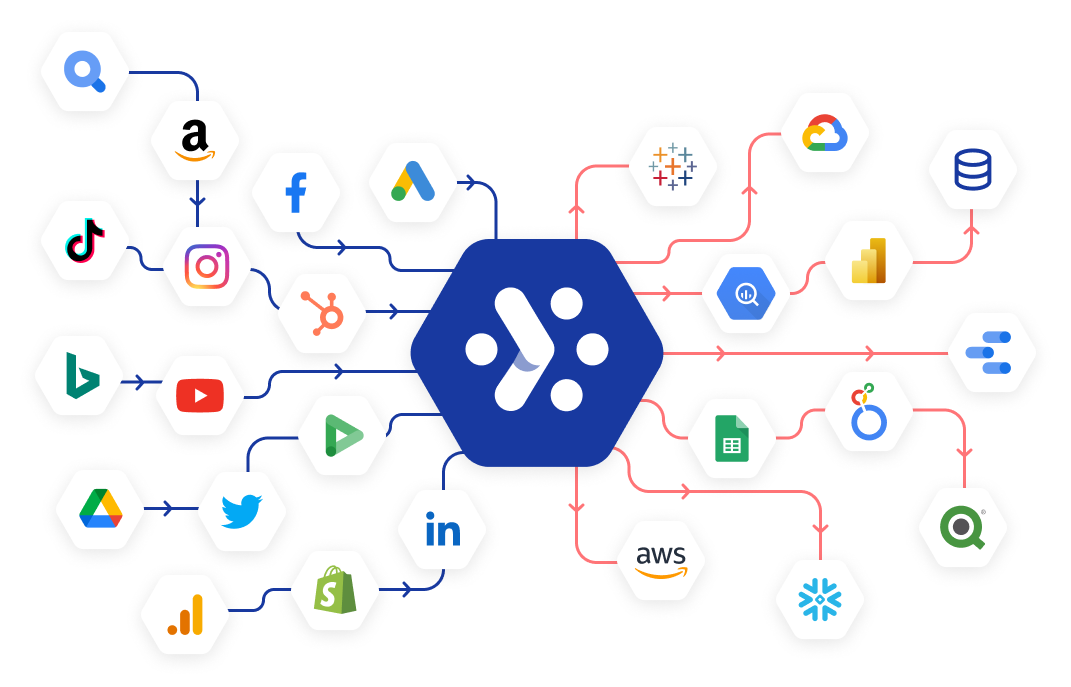
No, you’re in the people game. But people are complex. Their preferences, backgrounds, habits and behavior all vary massively. You need clear insights that enable you to understand your customers better. Advanced marketing analytics can provide these.
Meet your new friends: data integration. Data visualization. And augmented analytics. They have the power to make you into a world-class marketer. The secret is to develop a sophisticated reporting dashboard based on these technologies. A dashboard that drives your actions by unifying, then intelligently analyzing a wide variety of data sources. And not just marketing ones. The result: better ROI, higher revenues, successful campaigns, and a superior customer experience.

Editor-in-Chief at The Globe and Mail
Numerical business measures
Metrics used to measure business targets and outcomes
Here’s the great thing. Visualization dashboards let you follow an unlimited number of different metrics and KPIs. It’s up to you what you track. The main question to ask is why you want to track it. Maybe you want to optimize your ad spend.
Or you might want to improve the performance of an email campaign. Or work out how many customers you’re losing through churn. Perhaps you need to observe click volumes in an A/B Google Ads test.
Website-related data can be a great indicator of customer interest and engagement. Things like unique website visits, or conversions and goal completions for newsletter signups or demo requests.
Data that will help you track the success of your email campaigns includes email open rates, bounce rates and unsubscribes.
You can track the success or failure of your marketing campaigns by measuring page impressions, clickthrough rates, social shares and reach.
Cost per click, return on ad spend, click through rate and cost per conversion of data-centric measurements – these all tell you how effective your marketing spend is.
The next step is to organize your data structure and naming conventions. You want to make your dashboard as useful as possible when it comes to reporting on data.
For example, the best way to develop your UTM structure is to look at your marketing funnel. By assessing which assets are top of funnel (awareness), middle of funnel (evaluation) or bottom of funnel (purchase), you can set effective UTM tags. These parameters will enable you to track and visualize your marketing or promotional efforts more effectively on the dashboard.
On a more granular level, creating asset names can be a repetitive and time-pressured task. Errors can creep into naming conventions. Adverity has a Smart Naming Convention feature that will help. The module applies AI tech to understand a naming convention, highlight any discrepancies and suggest logical rules to categorize name parts.
So, by thinking carefully about data structure and naming conventions you can make your dashboard metrics and KPIs accurate and useful.
CAC represents the true cost of gaining a new service subscriber. It includes money spent on sales, marketing, advertising and commission.
CLTV is a sales-related metric that tracks the average amount of money your customers pay during their relationship with your company.
Well worth knowing. This KPI will indicate if your marketing campaigns and ad accounts are on, under or over budget. Very important.
CPC is ad spend divided by the number of conversions it generates. Data visualization can quickly show you which campaigns are financially on track.
MRR aggregates all revenue the business receives from paying customers each period, regardless of pricing plans and billing cycles.
This designates the percentage of customers the business has retained over a given period. You’ll want to watch this one closely.
Now for some nuts and bolts. Successful data visualization relies on great data integration and transformation: two vital technology processes that are also known as ETL (extract, transform and load). Data integration opens up data silos and assembles data from multiple sources. It works together with transformation to create a ‘clean’ and unified ‘data stack’.
So, for example, Adverity’s automated data integration technology can collect data from virtually anywhere. It uses data connectors and API-like connectors to process any type of data or format. Data could be provided in structured spreadsheets, unstructured and complex Excel files, .json or .xml files, among many others.
Once integrated, the Adverity platform applies its powerful transformation engine to the data to clean, normalize and unify it. It joins data from different sources, strips out the formats, enriches it with additional info, and applies rules to particular data segments to make them easier for analysts to handle. As part of this process the engine will fix errors, fill in missing information, and eliminate duplicate entries.
The advantages of having a clean data stack are immense. Particularly when it comes to data visualization. The perfect SaaS dashboard should give SaaS and technology business marketers exactly the information they need to discover actionable trends, patterns, anomalies and opportunities, and make real-time decisions. This all depends upon having trustworthy data.
Data visualization makes information beautiful. But it’s much more than that. Visualization matters because it drives actionable insights, using real-time graphics, charts and graphs.
With it you can see, at a glance, when demand for a specific app feature spiked. Or the point at which customers churned. Or when ad revenues exceeded expectations. This is all valuable intelligence.
Here are some pointers on how to build beautiful and effective dashboards.
If you can understand your customers, you can improve the customer experience. But you need to look closely at customer behavior. Metrics and KPIs can be of practical assistance here, particularly in tracking engagement.
CAC represents the true cost of gaining a new service subscriber. It includes money spent on sales, marketing, advertising and commission.
CLTV is a sales-related metric that tracks the average amount of money your customers pay during their relationship with your company.
Well worth knowing. This KPI will indicate if your marketing campaigns and ad accounts are on, under or over budget. Very important.
CPC is ad spend divided by the number of conversions it generates. Data visualization can quickly show you which campaigns are financially on track.
MRR aggregates all revenue the business receives from paying customers each period, regardless of pricing plans and billing cycles.
This designates the percentage of customers the business has retained over a given period. You’ll want to watch this one closely.
When it comes to visualizing your data, there are so many options. Particularly with a versatile platform like Adverity. There are many different types of interactive charts to choose from, to show your data off in the best way, especially when you use color effectively.
Behind any great dashboard is great data. Through automating data integration from hundreds of sources, our vendor-agnostic platform delivers a single view of marketing performance across your business. And with the help of the sorts of powerful data integrations illustrated in this playbook, Adverity creates tangible business impact from your marketing activities.

A leader in the automatic classified business, cars.com chose to implement Adverity to completely eliminate manual data processing, centralize disparate data sources and scale business performance through enhanced intelligence.
The business reduced its data wrangling times from 160 to 5 hours each week. They also achieved true return on ad spend in their campaigns for the first time ever.

Manager of Data Enablement, cars.com

Digital Marketing & Performance Data Analyst at Vodafone Italy